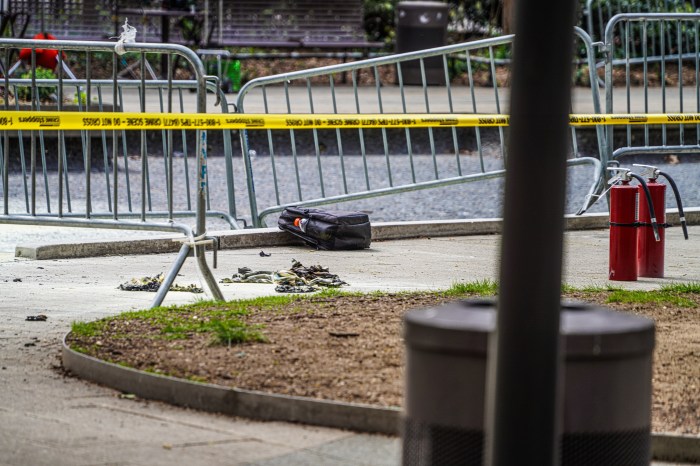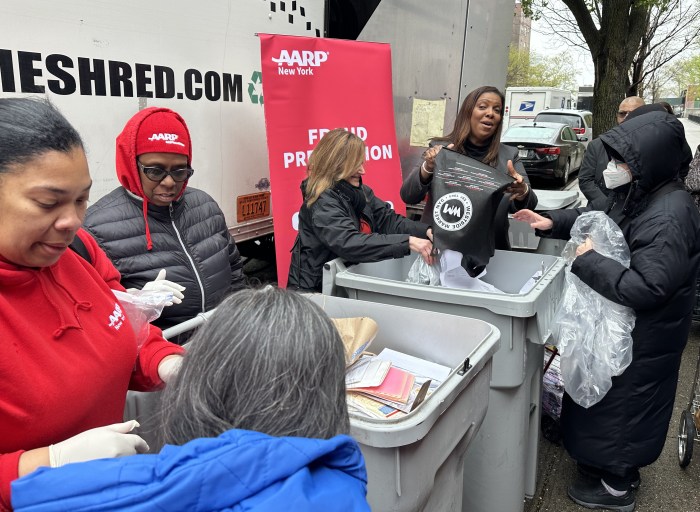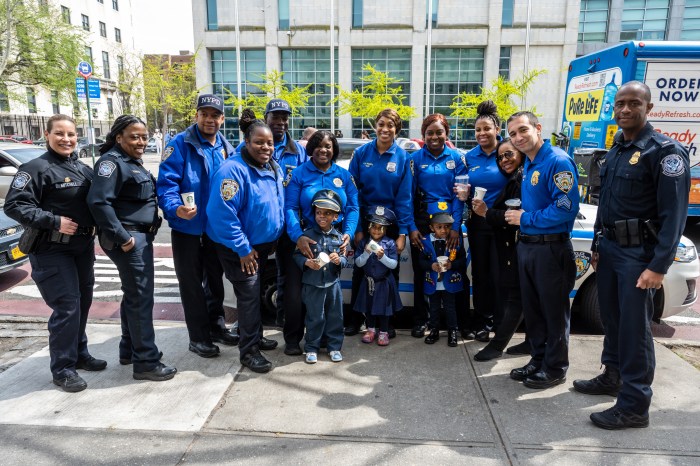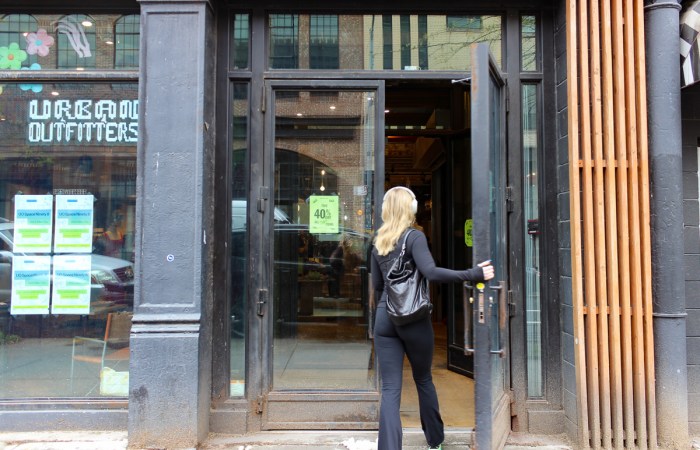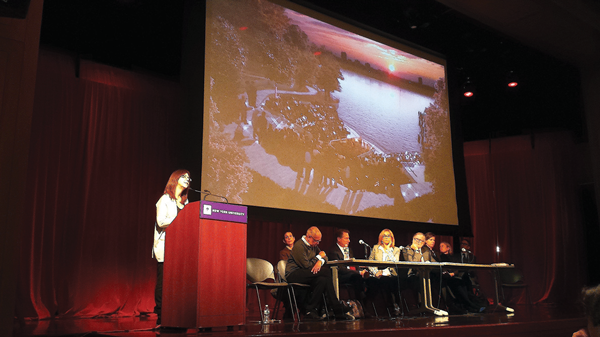
BY LINCOLN ANDERSON | Depending on who was testifying Monday evening, Pier55 — the planned $130 million “arts island” off of W. 13th St. — will either be a dazzling new outdoor entertainment venue and park or a colossal disaster waiting to happen, as in the Hudson River Park equivalent of “The Poseidon Adventure.”
As required for a “significant action” affecting the park, the public hearing was held to gather input on the proposed lease for Pier55, under which a nonprofit, Pier55, Inc. (or P55), headed by Barry Diller, would operate the pier for 20 years, with an option to extend the lease for another 10.
Media tycoon Diller and his wife, the fashion icon Diane von Furstenberg, have committed to contribute $113 million to build the new 2.7-acre pier, which would sit out in the river, north of the current Pier 54, connected to the rest of the park by two walkways. The city has pledged to kick in $17 million for the project.
Pier 54’s remaining deck would be removed, though its pile field would be left.
A crowd of about 150 listened as, at the hearing’s start, the project was presented and described by Madelyn Wils, president of the Hudson River Park Trust; landscape architect Signe Nielsen, who teamed on the new pier’s design with Heatherwick Studio; and Kate Horton and George C. Wolfe, who will be part of the high-powered team programming the pier’s entertainment.
Horton, former deputy executive director of the National Theatre of Great Britain, noted, “It’s a park first — and we’re very mindful of that.”
She said that, per Pier 55, Inc.’s mission statement, the performers would be a mix of emerging and established acts.
The majority of entertainment, she said, would happen in the pier’s 700-seat amphitheater, which is “based on a Shakespearean house,” and which would not have electric amplification.
The “Southern space,” at the pier’s south side, would be able to accommodate up to 200 people sitting on the surrounding lawns. Meanwhile, the central hardscape plaza would be able to seat up to 1,000 people for a show.
Fifty-one percent of the events would be free or low cost, per the Pier55, Inc. lease agreement with the Trust.
Wolfe, who had a residence at the Public Theater under the late Joseph Papp, said, “I consider myself a child of Joseph Papp.”
He said he’d like to see students from local schools be ushers at Pier55 or even background actors for plays there — “as faeries in ‘Midsummer’s Night.’ ”
He said he envisions different programming each year.
“The first season could conceivably be the waterfront — of immigration, of Melville, of the drag queens along the pier,” he said.
The floor was then opened up to testimony, first from elected officials, then from the rest of the public.
Manhattan Borough President said her main concern was “assuring maximum public access to the pier and events.”
Horton had assured that when the amphitheater, for example, would be in use, the rest of the pier would remain open to the public.
Brewer also was concerned about disabled persons’ access to all parts of the pier. For example, the pier’s 71-foot-tall southeast corner would not be handicapped accessible, she noted.
“It is very important to allow people with disabilities to access the same views that are available to others,” she noted.
However, she said she was glad that a viewing platform at that corner of the pier now will be provided so that disabled persons can enjoy the same vistas.
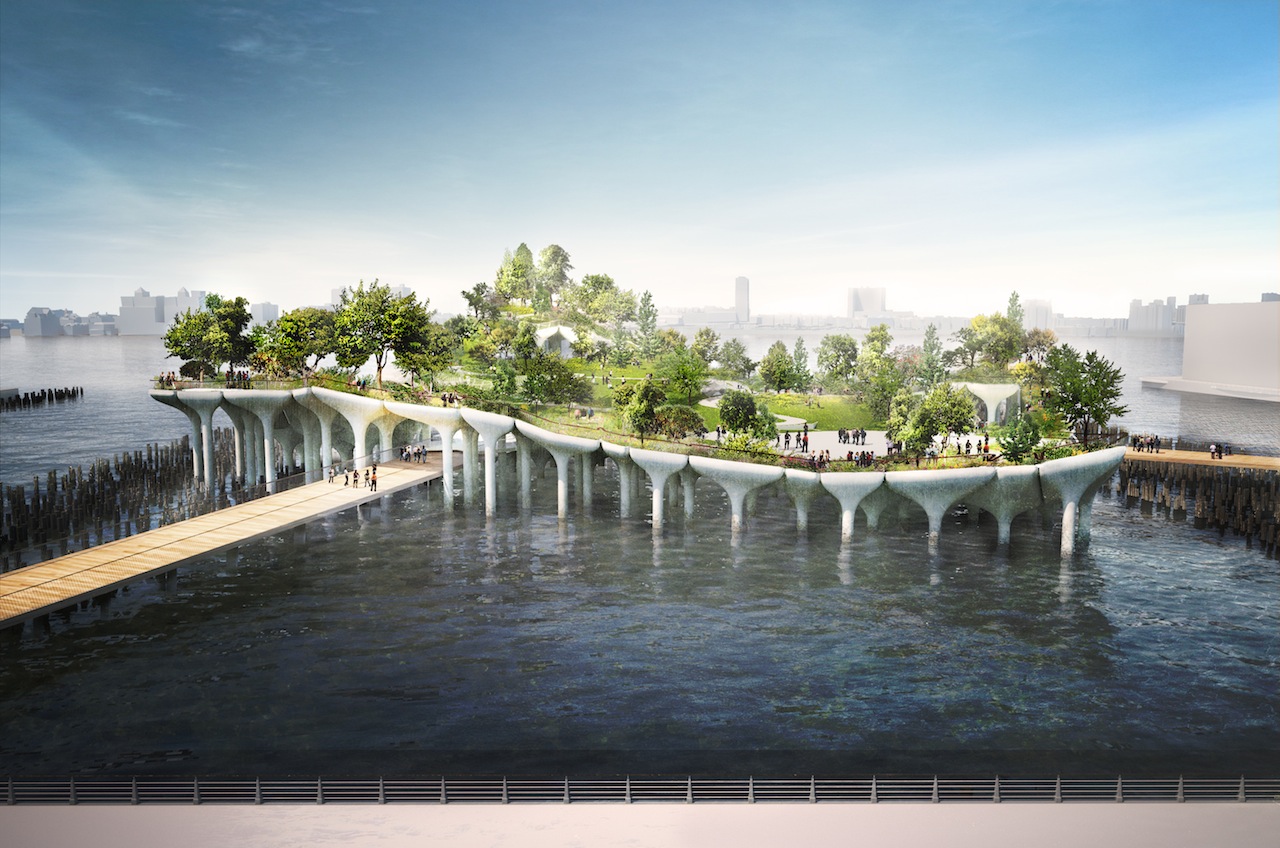
Brewer also worried the amount of programming on the pier. Under the lease, the pier would be allowed to have permitted events (events for which permits are required) six days per week.
“From the Fourth of July to Labor Day, I ask that the days without permitted events be greatly increased,” she said.
She also criticized the price range for ticketed “low cost” events — $5 to $40.
“I am concerned that the higher end of the range — $20 to $40 — would render large segments of this pier off limits to many New Yorkers,” she said.
In his testimony, state Senator Brad Hoylman said that, currently, the process for “significant actions” affecting the park pales in comparison to the city’s seven-month-long ULURP (Uniform Land Use Review Procedure) because local politicians don’t have a binding vote on it.
“As a result,” he said, “I am considering a way to legislatively mandate a more inclusive process.”
Similarly, Assemblymember Deborah Glick, in a statement, said, “Pier55 remains public space, and I’m troubled by the lack of public input on the pier’s radical reconstruction, which is actually a new development.”
Glick also was worried about an “actors’ barge,” which, under the plans, would be moored off the pier, and the impact of this vessel on the aquatic habitat beneath it.
She expressed gratitude at the “very generous gift” of Diller and DvF and said the team led by Horton and Wolfe is clearly “incredibly capable and thoughtful.”
“Nevertheless,” she said, “the community should have a voice in its own public spaces.”
Scott Lawin, vice chairperson of Friends of Hudson River Park, said Pier55 will be “a spectacular piece of design and architecture that will be enjoyed by everybody.”
But Bunny Gabel, a longtime Jane St. environmentalist, blasted “Diller Island” as a disaster waiting to happen.
Saying she was appealing to the Trust’s “common sense and humanity,” she pleaded, “Do not sign the lease for the Diller Island. Building this ugly thing will cost a lot. It will reduce the property value of inland buildings whose views will be blocked. There’s no need for building in water — build on land.”
The waterfront needs to be preserved, she stressed.
“What will end up on Gansevoort Peninsula, just south of Dillerville?” she asked. “Oops! Where did the Hudson River go?”
However, Adrian Benepe, the city’s former Parks Department commissioner, who used to sit on the Trust’s board of directors, was bullish on Pier55.
“I think this is a spectacular thing for New York City and the neighborhood,” he said.
Benepe noted the city’s tradition of philanthropy in building the 42nd St. Public Library building and the former Astor Library (the current Public Theater), among other magnificent edifices.
“The city and state have put $400 million into this park already,” he pointed out, by way of saying that — in tough budget times– the park sorely needs this private sector help.
The south side of the new heavily landscaped pier would be elevated and tilted upward to allow sunlight to penetrate to the water below, avoiding detrimental shading on the aquatic habitat.
“I think, over all, for people, for plants, for music and for the fish, this is a perfect plan,” Benepe said.
Philip Musegaas, Hudson River program director or Riverkeeper, said building the new Pier55 in a spot north of the current Pier 54’s footprint is a serious environmental issue.
“It’s a 2.7-acre pier being built in a new location,” he said. “That concerns us as stewards and guardians of the river. “And we’re concerned about the 4,000-square-foot barge. We’re not clear how often it will be there.”
He said that a full environmental impact study must be done for the project. A less-extensive environmental study has been done.
Will Rogers, from W. 16th St., said after giving it much thought, he came down against the idea.
“I basically oppose this,” he said. “Why this location? This area is already impacted by the Meatpacking District, Chelsea Piers, the Village, which has a unique cultural history.”
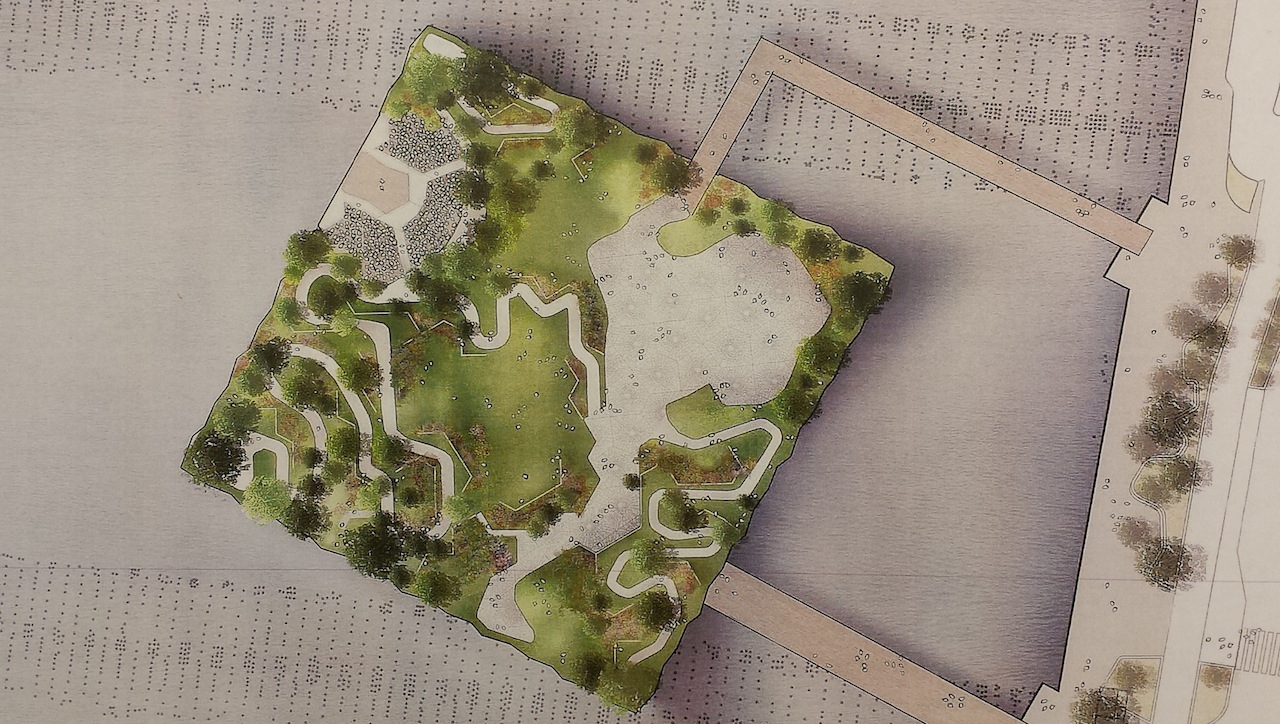
Joshua David, co-founder of Friends of the High Line, said his organization strongly supports Pier55.
“Creating a pedestrian loop on the pier, instead of a dead end is a good idea” and will hook the pier into the park and High Line foot traffic, he said.
He added that Diller and von Furstenberg were major supporters of the Gansevoort Historic District and the High Line.
Others speaking for Pier 55 included Susanna Aaron, a board member of Friends of Hudson River Park.
“The promise it holds for improving our cultural life is exceptional,” she said.
The new pier would be built above the flood plain, which is part of the reason why it would be set out in the river and accessed by gently sloping ramps. Still, some environmentalists said there shouldn’t be any more building in the water.
Andrew Lawrence, a member of the local Sierra Club chapter, referred to Westway, the highway-and-landfill mega-project that was defeated and replaced by Hudson River Park. As part of Westway, new development would have been added on top of the new landfill — and had that housing been built, it would have been devastated by Superstorm Sandy, he said.
“If Westway happened, we’d be looking at four miles of catacombs,” he said.
He said the Sierra Club would be “filing papers” before the deadline to submit written testimony.
Marcy Benstock of the Clean Air Campaign, who helped defeat Westway, said Pier55 would be a burden for taxpayers and put first responders at peril because concertgoers would need to be rescued from it during raging superstorms.
The “significant action” period started Nov. 17. Public comments will be accepted until midnight Jan. 23. For directions on how to submit comments, go to hudsonriverpark.org . On Feb. 11, the Trust’s board of directors will vote at a public meeting on whether to approve the Pier55 lease.











